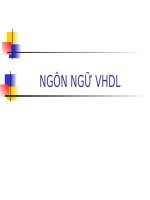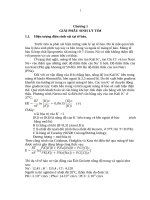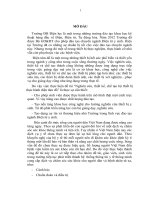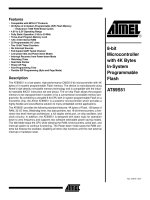ĐIỆN tử VIỄN THÔNG 22functions v9 khotailieu
Bạn đang xem bản rút gọn của tài liệu. Xem và tải ngay bản đầy đủ của tài liệu tại đây (257.08 KB, 40 trang )
Functions and Procedures
Objectives
After completing this module, you will be able to:
•
•
•
Declare a subprogram within a package, architecture, or process
Write functions and procedures
Call a subprogram within an architecture or process
Functions and Procedures - 22 - 2
© 2007 Xilinx, Inc. All Rights Reserved
Outline
•
•
•
•
•
•
•
Functions and Procedures - 22 - 3
Using Subprograms
Procedures
Parameter Classes
Range Attributes
Functions
Testbench and Common Usage
Summary
© 2007 Xilinx, Inc. All Rights Reserved
Using Subprograms
•
•
Most large designs use common functional blocks repeatedly
In both behavioral and RTL VHDL code, commonly used functions can
be defined within a subprogram
–
–
–
•
The subprogram can then be called as necessary throughout the design
Provides flexibility and modularity to the code
Reduces the volume of coding necessary in a large design
VHDL offers two types of subprograms: functions and procedures
Functions and Procedures - 22 - 4
© 2007 Xilinx, Inc. All Rights Reserved
Functions versus
Procedures
•
•
Functions and procedures differ in their usage and capabilities
Functions are used as an operator in an expression
–
–
•
Their parameters (arguments) can only be inputs (not outputs or inouts)
They must return a single result
Procedures can be used as a sequential or concurrent statement
–
–
Their arguments can be inputs, outputs, or inouts
They contain sequential statements that produce an effect
Functions and Procedures - 22 - 5
© 2007 Xilinx, Inc. All Rights Reserved
Outline
•
•
•
•
•
•
•
Functions and Procedures - 22 - 6
Using Subprograms
Procedures
Parameter Classes
Range Attributes
Functions
Testbench and Common Usage
Summary
© 2007 Xilinx, Inc. All Rights Reserved
Procedure Structure
•
•
A procedure can be declared with or without arguments
If arguments are listed, they allow greater utilization throughout
the design
Identifier
Keyword
Local
Declarations
•
procedure PROC1 is
variable VAR1 ;
begin . . .
(sequential statements. . .)
end procedure PROC1 ;
A procedure that has no parameters can be called simply by using its
identifier, such as PROC1 ;
Functions and Procedures - 22 - 7
© 2007 Xilinx, Inc. All Rights Reserved
Procedure Parameters
•
Procedure arguments are similar to port declarations—they can be inputs,
outputs, or bidirectional
–
–
–
Mode in can be read, but not changed; treated as constant
Mode out cannot be read, only assigned to; copied back to caller
Mode inout can be read and assigned to; copied back to caller
procedure PROC2 ( IN1: in <type> ;
OUT1: out <type> ;
BI_DIR1: inout <type> ) is
variable VAR2 ;
begin . . .
Formal
(sequential statements. . .)
Parameters
end procedure PROC2 ;
•
There are similar restrictions in terms of their usage within the procedure
Functions and Procedures - 22 - 8
© 2007 Xilinx, Inc. All Rights Reserved
Passing Parameters
•
If a procedure has arguments, it is called using its identifier and the
actual parameters, which then map to the formal parameters
That is, PROC2 ( D_IN, D_OUT, D_IO );
procedure PROC2 ( IN1: in <type> ;
OUT1: out <type> ;
BI_DIR1: inout <type> ) is
variable VAR2 ;
begin . . .
(sequential statements. . .)
end procedure PROC2 ;
Functions and Procedures - 22 - 9
© 2007 Xilinx, Inc. All Rights Reserved
Associating Parameters
•
As with the port map declaration, the call expression can explicitly bind
the formal and actual parameters via “named” association
That is, PROC2 ( IN1 => D_IN, OUT1 => D_OUT, BI_DIR1 => D_IO );
Formal
Actual
procedure PROC2 ( IN1: in <type> ;
OUT1: out <type> ;
BI_DIR1: inout <type> ) is
variable VAR2 ;
begin . . .
(sequential statements. . .)
end procedure PROC2 ;
Functions and Procedures - 22 - 10
© 2007 Xilinx, Inc. All Rights Reserved
Outline
•
•
•
•
•
•
•
Functions and Procedures - 22 - 11
Using Subprograms
Procedures
Parameter Classes
Range Attributes
Functions
Testbench and Common Usage
Summary
© 2007 Xilinx, Inc. All Rights Reserved
Parameter Classes
•
•
In addition to mode and data type, the formal and actual parameters
must also be of the same class
VHDL has four classes of objects
–
–
–
–
•
Constant
Variable
Signal
File
procedure PROC2 ( IN1: in <type> ;
OUT1: out <type> ;
BI_DIR1: inout <type> ) is
variable VAR2 ;
begin . . .
(sequential statements. . .)
end procedure PROC2 ;
Procedure parameter classes can use either default, explicit
constant, variable, or signal declaration
Functions and Procedures - 22 - 12
© 2007 Xilinx, Inc. All Rights Reserved
Default Parameter Class
•
•
•
A formal parameter of mode in will default to constant
A formal parameter of mode out will default to variable
A formal parameter of mode inout will default to variable
procedure PROC2 ( IN1: in <type> ;
OUT1: out <type> ;
BI_DIR1: inout <type> ) is
variable VAR2 ;
begin . . .
(sequential statements. . .)
end procedure PROC2 ;
Functions and Procedures - 22 - 13
© 2007 Xilinx, Inc. All Rights Reserved
Default Parameter Class
•
The most important consequence is that formal and actual must be
consistent. Therefore, in the previous example, the actual object
associated with OUT1 or BI_DIR must be declared as a variable
procedure PROC2 ( IN1: in <type> ;
OUT1: out <type> ;
BI_DIR1: inout <type> ) is
variable VAR2 ;
begin . . .
(sequential statements. . .)
end procedure PROC2 ;
That is, PROC2 ( IN1 D_IN, OUT1
D_OUT, BI_DIR1 D_IO );
Must be Variable
Functions and Procedures - 22 - 14
© 2007 Xilinx, Inc. All Rights Reserved
Example Procedure
•
The following procedure is used to reverse the order of bits (elements)
for a 32-bit array
procedure BIT_REV_32 ( IN_VEC : in std_logic_vector ;
OUT_VEC : out std_logic_vector ) is
begin
for i in 31 downto 0 loop
OUT_VEC(i ) := IN_VEC(31-i );
end loop;
end procedure BIT_REV_32 ;
Functions and Procedures - 22 - 15
© 2007 Xilinx, Inc. All Rights Reserved
Declaring the Procedure
•
If the procedure is declared within the package, its “body” must be
declared within the separate and dependent package body
library IEEE;
use IEEE.std_logic_1164.all;
Procedure
Declaration
package MY_PACK is
procedure BIT_REV_32 ( IN_VEC : in std_logic_vector ;
OUT_VEC : out std_logic_vector );
end package MY_PACK;
package body MY_PACK is
procedure BIT_REV_32 ( IN_VEC : in std_logic_vector ;
OUT_VEC : out std_logic_vector )is
begin
for i in 31 downto 0 loop
OUT_VEC(i) := IN_VEC(31- i);
Procedure
end loop;
end procedure BIT_REV_32 ;
Body
end package body MY_PACK;
Functions and Procedures - 22 - 16
© 2007 Xilinx, Inc. All Rights Reserved
Calling the Procedure
library IEEE;
use IEEE.std_logic_1164.all;
use work.my_pack.all;
entity MOD1 is
port ( IN_BUS : in std_logic_vector (31 downto 0);
...
OUT_BUS : out std_logic_vector (31 downto 0)
);
end MOD1 ;
In this call, the actual
parameters in the call are
positionally associated to the
formal parameters in the
procedure and must be of the
same class*
architecture RTL of MOD1 is
begin
process ( IN_BUS )
variable TEMP_BUS : std_logic_vector (31 downto 0);
begin
Sequential Call
BIT_REV_32 ( IN_BUS, TEMP_BUS );
OUT_BUS <= TEMP_BUS;
end process;
end architecture RTL;
Functions and Procedures - 22 - 17
© 2007 Xilinx, Inc. All Rights Reserved
Defining Output Parameters
•
Actually specifying the class of output parameters declared in the
subprogram is often helpful
–
Can simplify usage and enhance the readability of the source code
procedure PROC2 ( IN1: in <type> ;
signal OUT1: out <type> ;
BI_DIR1: inout <type> ) is
variable VAR2 ;
begin . . .
(sequential statements. . .)
end procedure PROC2 ;
–
In this example, the keyword
signal before the parameter
OUT1 declaration changes it
from a variable to a signal
class
The difference in use is that you are not required to declare a variable
within the process so that it can be passed into the subprogram and then
assigned to an output signal—as in the previous example
Functions and Procedures - 22 - 18
© 2007 Xilinx, Inc. All Rights Reserved
Call with Explicit Signal
Class
library IEEE;
use IEEE.std_logic_1164.all;
use work.my_pack.all;
Having declared the formal
parameter OUT1 as a signal,
you can pass the output port
OUT_BUS (signal) directly
entity MOD1 is
port ( IN_BUS : in std_logic_vector (31 downto 0);
...
OUT_BUS : out std_logic_vector (31 downto 0)
);
end MOD1 ;
architecture RTL of MOD1 is
begin
process ( IN_BUS )
begin
BIT_REV_32 ( IN_BUS, OUT_BUS );
end process;
end architecture RTL;
Functions and Procedures - 22 - 19
Sequential Call*
© 2007 Xilinx, Inc. All Rights Reserved
Explicit Input Parameter Class
•
Actually specifying the class of input parameters declared in the
subprogram is often helpful
–
Can simplify usage and expand the capabilities of the subprogram
procedure PROC2 ( signal IN1: in <type> ;
OUT1: out <type> ;
BI_DIR1: inout <type> ) is
variable VAR2 ;
begin . . .
(sequential statements. . .)
end procedure PROC2 ;
–
In this example, the keyword
signal before the parameter
IN1 declaration changes it
from a constant to a signal
class
The difference in use is that the actual signal is passed to the subprogram,
rather than a “snapshot”—as in the case of the default constant. This allows
VHDL signal attributes such as ’event to be applied
Functions and Procedures - 22 - 20
© 2007 Xilinx, Inc. All Rights Reserved
Outline
•
•
•
•
•
•
•
Functions and Procedures - 22 - 21
Using Subprograms
Procedures
Parameter Classes
Range Attributes
Functions
Testbench and Common Usage
Summary
© 2007 Xilinx, Inc. All Rights Reserved
Range Attributes
•
VHDL provides attributes for composite data types. The following range
attributes make subprograms more versatile and portable
signal H_BYTE : std_logic_vector ( 7 downto 0 ) ;
signal WORD : std_logic_vector ( 0 to 3 ) ;
range ‘left
range ‘right
range ‘low
range ‘high
range ‘range
range ‘length
range ‘ascending
range ‘reverse_range
...
Functions and Procedures - 22 - 22
H_BYTE ‘left
returns 7,
H_BYTE ‘right
returns 0,
H_BYTE ‘low
returns 0,
H_BYTE ‘range
returns 7 downto 0,
WORD ‘left
returns 0,
WORD ‘low
returns 0,
WORD ‘length
returns 4,
WORD ‘ascending returns true,
H-BYTE ‘reverse_range returns 0 to 7,
© 2007 Xilinx, Inc. All Rights Reserved
Knowledge Check
•
Using either the Notes section or the ISE™ software, re-write this
procedure to handle data of any length by using the VHDL range
attributes
procedure BIT_REV_32 ( IN_VEC : in std_logic_vector ;
OUT_VEC : out std_logic_vector ) is
begin
for i in 31 downto 0 loop
OUT_VEC(i ) := IN_VEC(31-i );
end loop;
end procedure BIT_REV_32 ;
Functions and Procedures - 22 - 24
© 2007 Xilinx, Inc. All Rights Reserved
Answer
•
Using either the Notes section or the ISE™ software, re-write this
procedure to handle data of any length by using the VHDL range
attributes
procedure BIT_REVERSE ( IN_VEC : in std_logic_vector ;
OUT_VEC : out std_logic_vector ) is
begin
for i in IN_VEC’range loop
OUT_VEC (i ) := IN_VEC ((IN_VEC’length-1) -i );
end loop;
end procedure BIT_REVERSE ;
Functions and Procedures - 22 - 25
© 2007 Xilinx, Inc. All Rights Reserved
Outline
•
•
•
•
•
•
•
Functions and Procedures - 22 - 26
Using Subprograms
Procedures
Parameter Classes
Range Attributes
Functions
Testbench and Common Usage
Summary
© 2007 Xilinx, Inc. All Rights Reserved









